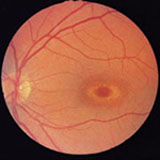
Management of patients undergoing hydroxychloroquine (Plaquenil) therapy
The quinolines, hydroxychloroquine (Plaquenil) and chloroquine are used primarily for their anti-inflammatory effects in the treatment of auto-immune conditions such as rheumatoid arthritis. Another common use of these drugs is the prophylaxis and suppression of malaria. The use of quinolines may cause several ocular side-effects.
The most significant complication is irreversible macular damage resulting in both visual acuity and visual field loss. However, the Royal College of Ophthalmologists, UK (RCO) recently recommended against the monitoring of patients receiving quinoline therapy as it was deemed to be too costly, given the low incidence of retinal complications.
In this article, we present a case of hydroxychloroquine retinopathy, describe the ocular changes associated with quinoline therapy and recommend an optometric review schedule for patients who are currently taking these drugs. Furthermore, we recommend a proactive approach toward medical practitioners prescribing these drugs for optometric-based monitoring of these patients.
|
Clin Exp Optom 2000; 83: 1: 32-36 Harrison S Weisinger* MScOptom PhD * Department of Food Science, RMIT University, Melbourne Accepted for publication: 5 December 1999 Also published November 16, 2001 Optom Today |
Advanced bull's eye retinopathy of left eye of patient receiving long-term chloroquine therapy. |
Key words: bullís eye maculopathy, corneal verticillata, hydroxychloroquine, Plaquenil, quinoline toxicity, retinopathy
|
|
![]()
Index of Papers
[ Welcome ][ Publications ]



 Clinical contact lens comparison
Clinical contact lens comparison